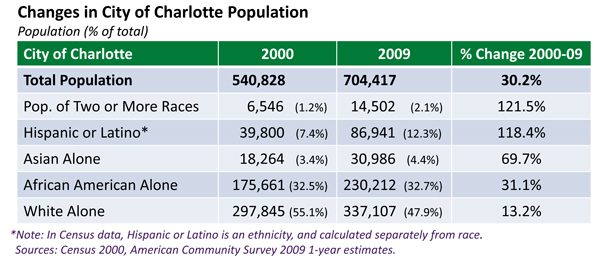Charlotte’s rapid growth brings demographic changes

Headlines have highlighted multiple demographic trends affecting Charlotte and the metro area over the last decade. “Carolinas lead the nation in Hispanic growth,” read the headline of a Charlotte Observer story in 2008. The city has ranked highly on “Best City” lists for African Americans throughout the 2000s. Moving beyond the headlines, however, is there any clear demographic picture emerging for Charlotte’s future? A glimpse at the 2009 Census Bureau data (the final estimates before the 2010 official counts are released later this spring) provides some insight.
The 2000s were a decade of real change in Charlotte. The city of Charlotte was ranked 6th in population growth and the metro area was ranked 7th in domestic in-migration since 2000 among the country’s 100 largest metro areas (based on percent change since 2000)1.
2009 Census estimates put the city of Charlotte’s population (excluding the rest of the metro area) at 704,417, a 30% increase since 2000. The table below shows how that population change compares across racial and ethnic groups. Triple-digit growth in both the Hispanic and multi-racial populations confirms that the changes have been substantial in the last decade. The Asian population has also grown dramatically, up almost 70%, putting the latest estimate of the Asian population at 4.5% of the city’s total population. The white population, on the other hand, grew at under half the city’s overall rate, but because of its larger base, still increased by nearly 40,000.
And what about the African American population change? Although the growth of the African American population has been substantial and represents an increase of almost 55,000 people, that growth rate was nearly the same as the city’s overall growth rate of 30%, meaning that the African-American population as a percentage of Charlotte’s total population is nearly unchanged from the previous decade.

In 2010, the Brookings Institute released a major report 2 which organized the country’s 100 largest metropolitan areas into 7 categories based on what it called the “new realities” emerging from the tumultuous 2000s. In that report, Charlotte’s metro area is classified as a “New Heartland” region, defined as:
“New Heartland metro areas are [also] fast growing, highly educated locales, but have lower shares of Hispanic and Asian populations than the national average. These 19 metro areas include many in the ‘New South’ where blacks are the dominant minority group, such as Atlanta and Charlotte, as well as largely white metro areas throughout the Midwest and West, such as Indianapolis and Portland (OR).”
Is this the new Charlotte? If so, for how long? In the coming months, we will be releasing extensive new data and analysis tools through our Regional Indicators project that will help explore these continuing changes. Stay tuned.
Photograph by Nancy Pierce
1Brookings Institution State of Metropolitan America ranks the 100 largest U.S. metros, and 95 cities within those metro areas. http://www.brookings.edu/metro/StateOfMetroAmerica.aspx
2Rankings from the Brookings Institute State of Metropolitian America Interactive Map, using Census 2009 1-year estimate data for the City of Charlotte. http://www.brookings.edu/metro/StateOfMetroAmerica/Map.aspx